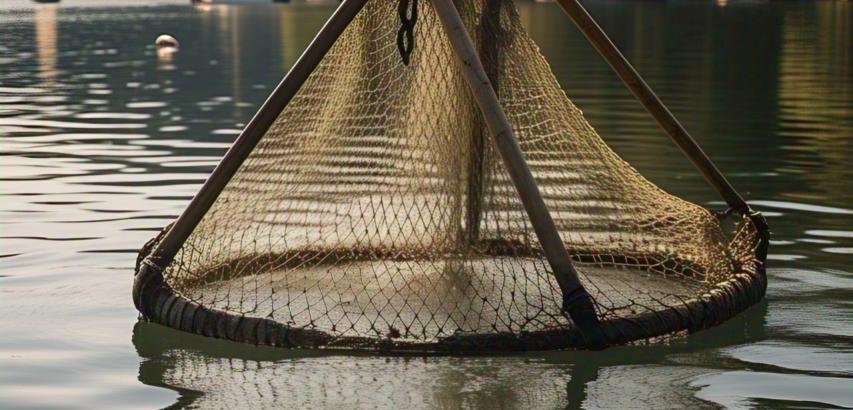Trap nets (or fish traps) are stationary fishing gear that guide fish into enclosures through funnel-like entrances, preventing escape. Used globally for sustainable harvesting of crabs, lobster, finfish, and cephalopods.
Core Components & Mechanics
Part | Function | Material |
|---|---|---|
Leader Net | Vertical barrier guiding fish toward trap | Nylon/Polyethylene mesh (8–15mm) |
Heart/Funnel | Cone-shaped entrance directing fish inward | Steel hoops + netting |
Pot/Chamber | Holding area where fish are trapped | Wood/wire mesh (1–2m³) |
Wings | Extensions widening the capture zone | Buoyed ropes + net panels |
Anchors Buoys | Stabilize system; mark locations | Concrete blocks + GPS buoys |
Common Types & Applications
Type | Design | Target Species | Deployment Depth |
|---|---|---|---|
Pound Nets | Large fixed traps with leader + heart + pot (coastal) | Herring, Salmon, Mullet | 5–30m |
Fyke Nets | Series of funnels + wings (rivers/lakes) | Eel, Perch, Catfish | 2–10m |
Lobster/Crab Pots | Baited rectangular/circular traps | Crustaceans | 10–200m |
Gargoor (Arab Style) | Dome-shaped wire traps (Middle East) | Grouper, Snapper | 10–50m |
Fish Wheels | Current-powered rotating traps (rivers) | Salmon, Shad | Surface |
Operational Advantages
✓ Selectivity:
Mesh size excludes juveniles/non-target species
Escape vents allow undersized fish to exit
✓ Low Bycatch: <5% compared to 20–80% in trawls/gillnets
✓ Fuel Efficiency: No active towing (90% less CO₂ than trawlers)
✓ Live Capture: 95% survival rate for non-retained catch
✓ Durability: 5–10 year lifespan with maintenance
Ecological Concerns & Mitigation
⚠️ Ghost Fishing:
- Solution: Biodegradable panels (e.g., cotton/polycaprolactone)
⚠️ Habitat Damage:
- Solution: Soft-bottom anchors; avoid coral/seagrass
⚠️ Overharvesting:
- Solution: Escape gaps, time-area closures, trap limits
⚠️ Marine Mammal Entanglement:
Solution: Acoustic pingers, rigid entrances
Global Regulations
Escape Vents: Mandatory in US/EU (e.g., 54mm rings in lobster traps)
Biodegradable Components: Required in Norway/Australia (panels degrade in 2–24 mos)
Marking: Colored buoys + RFID tags for ownership tracking
Seasonal Bans: Spawning/migration periods (e.g., salmon closures)
Innovations
Smart Traps:
Underwater cameras + AI identify species/sizes
Remote triggers release non-targets
LED-Lured Traps:
Blue/green LEDs attract target species (↑ catch 30%)
Modular Designs:
Collapsible traps for easy storage/transport
Bycatch Reduction Devices (BRDs):
Hinged gates exclude turtles/sharks
Commercial Viability
Factor | Small Scale | Industrial |
|---|---|---|
Trap Cost | $50–200/unit | $300–1,000/unit |
Catches | 5–20 kg/day | 200–1,000 kg/day |
ROI Timeline | 3–6 months | 1–2 years |
Labor | 1–2 fishers | Crew + monitoring tech |
Case Study: Blue Crab Trap (Chesapeake Bay)
Design: Two funnels + cull ring
Bait: Menhaden fish
Catch: 12–25 crabs/trap
Sustainability:
35% escape rate for sub-legal crabs
0.1% terrapin bycatch (vs. 7% in nets)
Future Trends
Satellite-Enabled Traps:
Transmit location/catch data via IoT
Hybrid Traps-Aquaculture:
"Fish aggregating" traps + offshore farms
Deep-Sea Mineral Guards:
Traps prevent mining debris dispersal
Did You Know? Archaeologists found 9,000-year-old woven fish traps in Denmark – the same principle still used today!
Trap nets represent one of fisheries' most ecologically balanced tools, combining ancient wisdom with modern tech. When regulated properly, they support food security while minimizing ecosystem harm – a critical solution for sustainable seafood amid declining global stocks.
 |  |  |
Buy Fishing Trap Net - Amazon
 |  |  |
